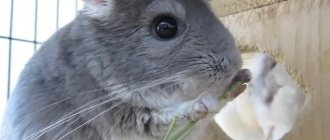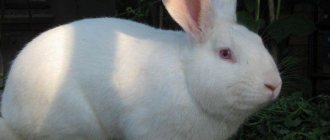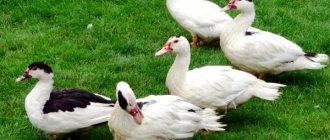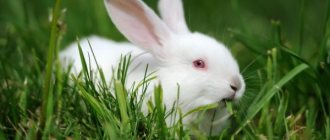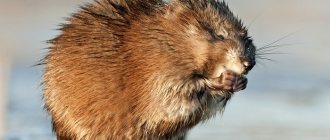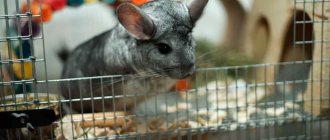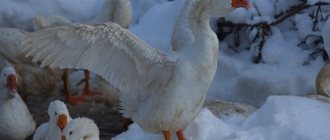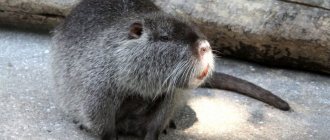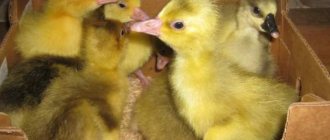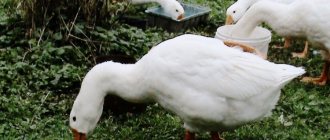Some important information about nutria
Nutria, or swamp beaver, is a rodent that leads a semi-aquatic lifestyle. The animal’s homeland is South America, so it is poorly adapted to Russian frosts. In winter, animals are kept in warm rooms, in cages.
The appearance of nutria cannot be called cute. They look like a huge rat with a long, hairless tail and large orange incisors protruding from their mouth. The body length of an adult reaches 60 cm, the weight of males is 10–12 kg, females weigh up to 7 kg. Animal meat is tender, juicy and tasty.
The fur of the animal is brown or gray-brown in color, with long guard hairs, and has excellent water-repellent properties. Animal skins are used to make hats and fur coats.
The rodent feeds on plant foods that it can find in the coastal zone: reeds, cattails, and water lilies. On farms, livestock are fed hay, vegetables, and grain.
Choosing a breed
Growing nutria for their skins forces the farm owner to pay attention to the color of the animals. There are two types of animals that are bred at home: standard and colored.
- Standard nutria are practically no different from their wild relatives. They are easy to care for and not picky about food. Females have a pronounced maternal instinct and are caring for their offspring. The nature of the animals is calm. The fur color of the animals is “wild” - brown, brown (light and dark), black.
- Colored nutria have different fur colors: white, fawn, red. Animals require comfortable living conditions and a balanced diet.
Colored nutria are divided into two types based on the principle of color inheritance: dominant and recessive. Dominant colors include:
- golden - light yellow coat color that shimmers beautifully in the sun;
- black is the most expensive fur on the market;
- white - the color creates the illusion of a thicker pile on the skin than it actually is.
Black
White
Golden
Recessive color group includes:
- pearlescent color of the skin, which can be obtained by crossing beige and white animals;
- cream color - characteristic of the white Italian breed;
- beige - can have different shades: sand, silver, cream.
Obtaining colored nutria requires knowledge in the field of genetics and the characteristics of the inheritance of color in offspring.
Some colored nutria have reduced immunity and low fertility rates, which can lead to degeneration. Crossbreeding with individuals of other colors is necessary to maintain the health of the animals.
How to distinguish a male from a female
The swamp beaver has pronounced sexual dimorphism, that is, the male is noticeably larger in size than the female. With 100% probability, you can determine the sex of an animal by its genitals. To do this, you need to pick up the rodent.
You need to hold your pet with both hands by the skin on the back of the neck and the root of the tail. The animal is placed on its back, with its tail facing itself, and the fur on the lower abdomen is spread apart. In the female, the genital slit looks like an oblong hole located close to the anus. The male's penis is hidden under the skin, only the tip sticks out, looking out through a round hole on the stomach, at a considerable distance from the anus.
Nutria breeding methods
There are several methods for breeding these animals. The choice of the appropriate one depends on the conditions of detention and the result that needs to be obtained as a result of mating.
Homogeneous
This is a method of breeding nutria according to a uniform (homogeneous) trait. It consists of selecting parent pairs that are similar to each other in key characteristics: color, build, hair structure, growth rate and the number of puppies in the litter. The young obtained from such animals will be almost a complete copy of their parents.
The homogeneous method is used to consolidate breed qualities or enhance a desired trait in pets.
Heterogeneous
On large fur farms with large numbers of animals, it is customary to breed nutria using a heterogeneous method. Its essence is the mating of animals with different characteristics. For example, one animal has good thickness and length of fur, while the other has the desired color. When crossing, there is a chance to get a nutria with fur of the desired shade, thickness and length.
The probability of giving birth to puppies with the necessary characteristics does not exceed 50%. Offspring are carefully selected for further breeding.
Mating
Puberty of male nutria occurs at 4-5 months of their life, while the mating period of females is usually delayed until the 7th or 8th month, when the animals gain at least 4-5 kg of weight. The most popular mating method is the transfer method, when already on the second day after the birth of the offspring, the female is temporarily transferred to the male, and then returned to the offspring again. This procedure is repeated for five days in a row, and the signal for a successful result will be combing the body in between matings.
Video: when to place a male with nutria
If the female has not been fertilized, after completion of lactation she is transferred to cages for shoal mating, but for this it is necessary to select only individuals with calm behavior. The average time for animal mating is 1-2 minutes, with the process repeated at least 4-8 times.
The absence of sexual heat in a female will be noticeable by her behavior when in contact with a male: if she screams and tries to hide from him, it is worth transplanting her back into her cage, repeating the process after a few days (preferably in the evening). If the union does not work out and the relationship between the female and the male often leads to fights, you will have to find other pairs for them. When kept in apartment conditions (sometimes the animals are used as pets), the male can be castrated, which will make him calmer.
Mating with nutria
The ability to mate in animals occurs at 3–4 months of life, but nutria are allowed to breed only at 7 months. By this age, the rodent reaches the necessary physiological maturity and can give birth to strong, viable offspring.
Sexual heat in females occurs all year round. The favorable moment for conception lasts about 25–45 hours. Determining the moment suitable for mating is simple - the female, without aggression, allows the male to approach her and allows him to cover.
Nutria pregnancy lasts 128–137 days. Already on the third day after giving birth, the female is ready for mating, but in order not to weaken the animal with a new pregnancy, coverings are not allowed.
Mating all year round
On farms where nutria are provided with comfortable living conditions and adequate nutrition, year-round breeding is practiced. One female produces up to 3 puppies per year.
Seasonal mating
It is practiced when keeping nutria at home, on small farms. Seasonal mating of all adult females has its advantages:
- makes caring for young animals easier;
- allows you to save space by building common walking areas for all puppies separated from their mothers at once.
Mating of animals occurs twice a year - in early spring and early autumn.
Manual mating
Practiced for novice livestock owners. The method consists of keeping a male and a female together during a period favorable for conception.
The male is placed in a cage with the female and her behavior is observed. If she is not aggressive towards the male, the animals are left to live together for a while, sometimes until childbirth. When the expectant mother begins to build a nest in preparation for whelping, the male is removed from the cage so that he does not cover the female immediately after birth.
School mating
This method of breeding animals is practiced on young animals. Female nutria who have not yet given birth are released into a spacious cage or enclosure. When they get used to it a little, males are allowed near them. After the pets have become accustomed to each other, the extra individuals are removed, leaving only the animals selected for breeding purposes.
Family mating
Similar to school mating, except for the number of animals in one cage. A nutria family is formed from one male and 3–5 females, slightly younger than him in age. Females in a family can be related to each other (such animals get along more easily), but the male must be taken from another clan.
By the time of birth, it is necessary to take care of separate nesting houses for females. Otherwise, nutria can confuse the cubs and even strangle other people's puppies.
Where to start breeding - tips for beginners
First you need to decide on the purpose of growing nutria. This may be breeding for sale of meat, skins or keeping as a pet. Nutria are well accustomed to the house and owner, respond to nicknames and recognize the intonation of a person’s voice.
To breed animals for fur sales, you should choose them of the same color. Their molting ends by the end of autumn; in winter the skins can be sold. Standard rodents are most suitable for meat, since they reproduce faster than others and quickly reach the desired size.
Features of housing organization - parameters of cages and enclosures
The maintenance of nutria must be organized taking into account seasonality. The cages must be hidden from direct sunlight in summer and from draft winds in the cold season. In harsh winters, their paws and tails can freeze, so insulating the home is the basis for preparing heat-loving animals for frost.
The living room must be equipped with sufficient lighting and an air ventilation system. Wooden floor elements are unacceptable, as nutria can easily chew them. If there is not enough space, they can show aggression towards each other. The size of the cells must be at least 150 x 75 x 60 centimeters.
Since nutria are waterfowl, the presence of a large amount of water in their life is very important. To ensure that the skin is always in good condition, it is necessary to install water containers with a capacity of 150–200 liters in the enclosure for walking animals.
Nutria are distinguished by their cleanliness; they have virtually no odor characteristic of other types of rodents.
Care and maintenance
To raise heat-loving animals, you need to take care of a room where in winter the temperature will not drop below +5 degrees. Comfortable temperature for animals is from +10 to +25 degrees.
Another point to remember is the ability of the swamp beaver to gnaw even small logs and dig holes in the ground. Only metal and concrete are immune to the teeth of rodents.
For nutria, a source of clean water close to their home is vital. This can be a natural or artificial pond.
In cells
Cages for nutria are constructed from durable metal mesh. In regions with mild winters, animals are placed outside with a sun shelter built for them. In temperate climates, the cages are made portable and moved to an insulated room for the winter.
Dimensions of a standard cage for a female with cubs:
- length of the entire cage - 260 cm;
- height - 50 cm;
- width - 80 cm;
- The dimensions of the queen cell (wooden house) are 60 by 80 cm, height - 50 cm.
The bottom of the cage is made of mesh, and a tray for collecting manure is installed underneath it. The lid of the queen cell is made removable to facilitate inspection of the offspring and cleaning of the nest.
In the enclosures
In the south, it is practiced to keep nutria at home in enclosures. It is convenient to keep animals in family groups in such pens.
To do this, one or more houses are built from bricks on the street. A plot of land with an area of 10–20 square meters. m is fenced off with a metal mesh, which is buried 40–50 cm into the ground so that the animals do not dig a hole into the wild.
A slope is formed on the site in the direction from the house, imitating the natural coastal slope. A swimming pool or artificial pond is installed in the lower part of the walking area. They practice separating a part of a natural reservoir with a net. For a family of nutria, 3–4 square meters is enough. m of reservoir area. The depth of the pool should not exceed 35–40 cm.
In regions with cold winters, enclosures are built without houses, but with sheds for summer housing and fattening of young animals.
In the pits
Keeping nutria in pits has been successfully used in areas with hot summers and the absence of bodies of water where the rodent could cool off. The pit is the same enclosure, but buried 70–120 cm into the ground. In the pit, the air temperature is 5–7 degrees lower than on the surface of the earth.
To prevent the animals from escaping from the pit, the bottom is concreted, hay is laid under the nutria’s paws, and the walls are reinforced with slate or iron sheets.
For convenience, several pits with mesh partitions are built. If it is necessary to remove a male or grown young animals, they are moved to a neighboring dwelling. Rodents see each other, communicate through the net and behave calmer.
Content
Keeping nutria at home involves meeting all the animals’ needs for nutrition, home improvement and further care, so every livestock breeder should carefully study all aspects of this process.
Terms and requirements
Like rabbits, nutria love warm rooms, always without drafts. For this reason, even a spacious cage in the cold season is by no means the best option for keeping animals. The temperature in their place of residence in any season should not fall below +15°C, otherwise mass death of animals is possible. In addition, a sufficient amount of sunlight is a prerequisite, which is why one wall of the cage is always made of mesh.
Animals should be walked daily, since the lack of fresh air negatively affects not only their well-being, but also the appearance of their fur coat. Don’t forget about the demands of animals on water. Nutria love to swim, so in their natural habitat they always organize their burrows near bodies of water. Sometimes they even dive, staying underwater for up to 10 minutes.
If you reduce the keeping of animals only to the cage method, then although this will save money, it will entail excessive accumulation of fat in the animals, which always negatively affects the quality of the fur. It is advisable to bathe rodents daily, or you just need to move them into a spacious enclosure with a small pond (you can pour a full bath of cold water).
Equipment
The best option for a home for nutria is a warm room, divided into several parts . One zone may be intended for feeding, and the second for nesting. In addition, do not forget to organize a walking area, and then place a spacious container of water in it, or organize a small lake where animals can swim to their heart's content.
Of course, each animal’s housing must provide a place for installing feeders and drinkers, and in order to prevent liquid spillage, it is worth paying attention to vacuum or nipple versions of such structures, tightly fixed to the cage wall. Of the feeders, bunker, standard or nursery varieties with high sides will be equally relevant.
What to feed nutria
To successfully keep nutria, you need to take care of their proper feeding. The swamp beaver's menu includes grass, hay, twig food, vegetables and fruits, grain or mixed feed.
Feeding of livestock depends on the season. In summer the animals are fed:
- dried meadow grass;
- young reeds and cattails;
- tender shoots of willow, oak, poplar, apple, pear, birch, cherry;
- vegetables from the garden - cucumbers, zucchini, watermelons, carrots;
- tops of beets and carrots, peas, Jerusalem artichoke and corn.
Among the grain crops, nutria eats oats, barley, corn, sorghum, and peas.
The winter diet consists of the following components:
- hay - legume or meadow;
- feed or grain mixture;
- vegetables - pumpkin, carrots, fodder beets.
Potatoes are given to nutria boiled and included in the diet of fattening animals.
In winter, vitamins and mineral complexes (premix) are added to the food to maintain strong immunity of pets.
Features of keeping nutria in winter
But in winter, keeping nutria is much more difficult, because adult individuals need to be moved to an insulated barn with a temperature of at least 8 degrees Celsius, and queens and babies must be kept in a heated room - at least 16 degrees plus.
At the same time, the room should have good ventilation (but not a draft!) and illumination, which can be adjusted with fluorescent lamps, turning them on for 16 hours every day. Light is especially important for pregnant and lactating females, as well as for males during mating.
Too high an air temperature will also have a negative impact on your pets, so don’t overdo it - the temperature in the nutria’s room should not exceed 20 degrees.
If it is not possible to pick up nutria from the street, then their houses should be carefully insulated. Please note that animals do not tolerate low temperatures well and can get frostbite on their paws and tails.
In this case, the water in the drinking bowls will also need to be heated so that it does not freeze and the nutria do not catch a cold. In addition, pets should be provided with a thick layer of bedding. Inspect the animals regularly and, in case of frostbite, take immediate action.
Changes also occur in the winter diet - instead of grass, they give hay, which can be replaced from time to time with vegetables and fruits.
There should be no rot on fruits and vegetables. Partial green food can be replaced with algae and tree branches.
Cleaning the room where nutria are kept should be done at least 3 times a week. Remove urine and feces using a broom and shovel. In this case, the animals are driven into the corner of the cage and blocked with a feeder or drinking bowl. Under no circumstances should you use water during cleaning, as it may freeze and the nutria will get frostbite on their paws.
Nutria diseases
Rodents rarely get sick, but there are several ailments that are common to this group of animals.
- Tuberculosis. An incurable disease that is common among weakened individuals. If nutria loses weight, refuses food, or coughs, it is urgently moved to an isolation ward for an accurate diagnosis. Animals with tuberculosis are destroyed.
- Paratyphoid . A contagious disease carried by migratory birds. Animals living outside and having access to open water suffer. Symptoms of paratyphoid fever are diarrhea, lethargy, miscarriages in females. Sick individuals are subject to destruction, healthy livestock are regularly vaccinated.
- Coccidiosis (emiriosis) . A common disease caused by protozoa that live in the intestines and liver of animals. Nutria become infected through dirty bedding. Pets living in cages almost never get sick. Symptoms: bloody diarrhea, weight loss. Treatment consists of administering coccidiostats and eliminating contact of the nutria with its own droppings.
Like other animals, nutrias can have worms. As a preventative measure, livestock are given anthelmintic drugs (Alben, Levamisole) twice a year.
If comfortable living conditions are created for the animals and preventive measures are carried out in a timely manner, nutria do not get sick and delight their owners with weight gain and multiple litters.
How do nutria reproduce at home?
Puberty in nutria occurs at the age of 4–5 months, but it is recommended to breed a female for the first time at 6 months. This is done during heat, when the animal shows signs of anxiety. If fertilization occurs during mating, as evidenced by a change in the behavior of the individual, the female is placed in a separate cage.
The duration of pregnancy in nutria is 4.5 months. During this period, the animal needs rest. It's good if the expectant mother moves a lot. An active lifestyle helps improve metabolism and a favorable outcome of labor.
Reproduction of nutria at home occurs quickly and allows you to produce offspring twice a year. The female gives birth to from 4 to 15 puppies, whose weight is 200–250 grams. They are born sighted and independent. Babies begin to swim 2 or 3 days after birth. Their weight increases rapidly due to the nutritional value of mother's milk.
